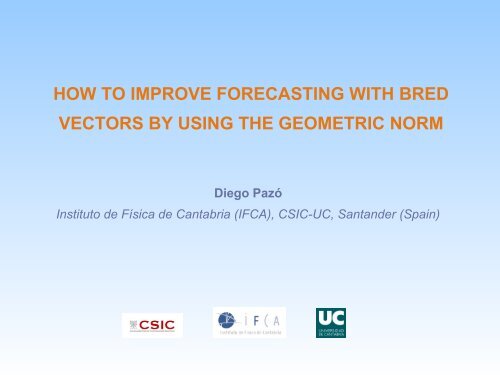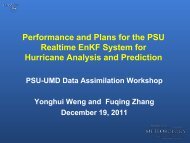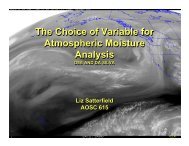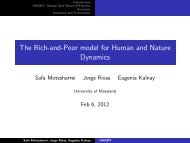T - Weather-Chaos Group
T - Weather-Chaos Group
T - Weather-Chaos Group
You also want an ePaper? Increase the reach of your titles
YUMPU automatically turns print PDFs into web optimized ePapers that Google loves.
HOW TO IMPROVE FORECASTING WITH BRED<br />
VECTORS BY USING THE GEOMETRIC NORM<br />
Diego Pazó<br />
Instituto de Física de Cantabria (IFCA), CSIC-UC, Santander (Spain)
Santander
OUTLINE<br />
1) Lorenz '96 model.<br />
2) Definition of bred vectors.<br />
3) Structure and growth of bred vectors, the role of the norm.<br />
4) Enhancement of ensemble diversity with the geometric norm.<br />
5) Forecasting with bred vectors: Euclidean vs. geometric norm.
SPATIO-TEMPORAL CHAOTIC SYSTEM: LORENZ '96 MODEL<br />
d ux , t <br />
=−u x−1,t [u x−2,t −u x1,t ]−u x ,t F<br />
dt
LORENZ '96 MODEL: 'LINEAR TANGENT EQUATIONS'<br />
d ux , t<br />
=−[u x−2, t−u x1, t] ux−1,t −ux−1,t[u x−2,t −u x1,t ]−u x ,t <br />
dt<br />
∥ut ∥≃∥ut=0∥ exp n t <br />
Lyapunov spectrum (F=8 ):
THE LYAPUNOV VECTOR<br />
The Lyapunov vector g(x,t) exhibits dynamical localization.<br />
Log-normal<br />
stats.<br />
h(x,t)=ln|g(x,t)|<br />
h(x,t)=ln|g(x,t)|<br />
Normal<br />
stats.<br />
In log scale the LV belongs to the universality class of the Kardar-Parisi-<br />
Zhang (KPZ) equation:<br />
∂ t<br />
h = ξ + 2 h + (h) 2<br />
Stretched-exponential localization of the Lyapunov vector:<br />
∣g x∣~e −k ∣x−x 0 ∣<br />
In log-scale the Lyapunov exponent λ becomes a speed: L=∞− L~L −1
BRED VECTOR
ERROR BREEDING – Toth & Kalnay (NCEP, 1993)<br />
The 'breeding method': inexpensive procedure for generating ensembles.<br />
Bred vectors (BVs) are finite perturbations periodically 'scaled down'.<br />
u'(t)<br />
b(t m<br />
)<br />
b(t m+1<br />
)<br />
t=0<br />
T<br />
u(t)<br />
ut m<br />
=u' t m<br />
−ut m<br />
bt m<br />
= u t m<br />
∥ u t m<br />
∥ u' t m =ut m bt m <br />
m=m+1
DEFINITION OF THE NORM<br />
We have selected a spectrum of qnorms: ∥ u∥ q =[<br />
q] 1 ∑ L<br />
1/q<br />
∣ ux , t ∣<br />
L x=1<br />
q=2 is the Euclidean norm.<br />
q=∞ is the supremum norm:<br />
q=0 is the geometric norm:<br />
∥ u∥ ∞ =sup {∣u x ,t∣} x=1,, L<br />
L<br />
∥ u∥ 0 =∏∣u x ,t ∣ 1 / L<br />
x=1<br />
L<br />
Note that h= 1 ∑ h x , t =ln∥ u x ,t∥<br />
L 0<br />
x=1<br />
“Logarithmic bred vectors”<br />
ut m<br />
=u' t m<br />
−ut m<br />
b t m<br />
= 0<br />
ut m <br />
∥ ut m<br />
∥ 0<br />
u' t m<br />
=ut m<br />
bt m<br />
<br />
m=m+1
BRED VECTORS<br />
The “bred vectors surface” is roughly a piecewise copy of the LV surface<br />
There is a nonlinear barrier that breaks the BV in several pieces !
ENSEMBLE of BVs
ENSEMBLE DIVERSITY → ENSEMBLE DIMENSION<br />
For an ensemble of k bred vectors {b q (i) } i=1,...k<br />
we define the ensemble diversity<br />
in terms of the ensemble dimension.<br />
k<br />
D en t= ∑ i=1<br />
i<br />
eigenvalues of the kk covariance matrix<br />
k<br />
∑<br />
i=1<br />
i<br />
2<br />
i<br />
C ij<br />
t =<br />
〈b i <br />
q<br />
, b j q<br />
〉<br />
L∥b i <br />
q ∥ 2 ∥b j q ∥ 2<br />
D en<br />
=3 D en<br />
2 D en<br />
1
The amplitude q controls the average ensemble dimension<br />
k=10 BVs
THE GEOMETRIC NORM (q=0) vs. THE OTHER q-NORMS<br />
The ensemble dimension D en<br />
(t) exhibit smaller fluctuations for q=0<br />
3
The PDF of D en<br />
shows that D en<br />
=1 is statistically significant for q≠0
=〈 [ D en<br />
t −〈D en<br />
〉] 2 〉 1/2
THE GEOMETRIC NORM (q=0) vs. THE OTHER q-NORMS<br />
Larger projection on the leading Lyapunov vector<br />
i t =∢ gt , b q i t <br />
LV<br />
BV's<br />
<br />
LV<br />
BV's
Larger localization. (Squared) surface width:<br />
V t =[h x ,t −h ] 2
THE GEOMETRIC NORM (q=0) vs. THE OTHER q-NORMS<br />
Larger growth rate (FSLE) = 1 T 〈 ln ∥ ut mT ∥ 2<br />
∥b q t m ∥ 2<br />
〉
ensemble FORECASTING with BVs
ENSEMBLE FORECASTING<br />
Leith (1974): Ensemble mean outperforms deterministic forecasting.<br />
truth<br />
Ensemble mean
ENSEMBLE FORECASTING: q=0 vs. q=2<br />
We carry out a simple experiment of ensemble forecasting with bred vectors. We<br />
compare the Euclidean (q=2) and the geometric (q=0) norms.<br />
Assimilation of the true state of the system (independent of the forecasting)<br />
The model is assumed to be perfect. Truth is represented by an independent run.<br />
Observations are performed every 0.05 t.u. with Gaussian errors of variance 2 =0.01.<br />
The state of the system is assimilated via a standard 3D-Var method:<br />
u ca : Control analysis<br />
u cf : Control forecast<br />
y : Observations<br />
u ca =u cf BBR −1 y−u cf <br />
B : forecast covariance matrix<br />
R : error covariance matrix
ENSEMBLE FORECASTING: q=0 vs. q=2<br />
Breeding: we 'breed' five perturbations: At the assimilation times they are<br />
rescaled down to a size ε q<br />
(and centered at the analysis) .<br />
Forecast: the five perturbations (+ the negative of them) are integrated for a time t lead<br />
The performance of the forecast is quantified by the root-mean-square error<br />
between the truth and the ensemble mean.
ENSEMBLE FORECASTING: q=0 vs. q=2<br />
The Rank histogram
ENSEMBLE FORECASTING: q=0 vs. q=2<br />
The continuous ranked probability score
CONCLUSIONS<br />
Bred vectors depend on the norm type.<br />
An ensemble of logarithmic (q=0) bred vectors exhibits weaker<br />
fluctuations<br />
while its members<br />
1. are more strongly projected on the leading LV.<br />
2. have larger growth rates.<br />
The geometric norm improves forecasts with bred vectors.<br />
Thanks to my collaborators: Miguel A. Rodríguez, Juan M. López,<br />
Sarah Hallerberg, Ivan G. Szendro, Sixto Herrera, Jesús Fernández.







